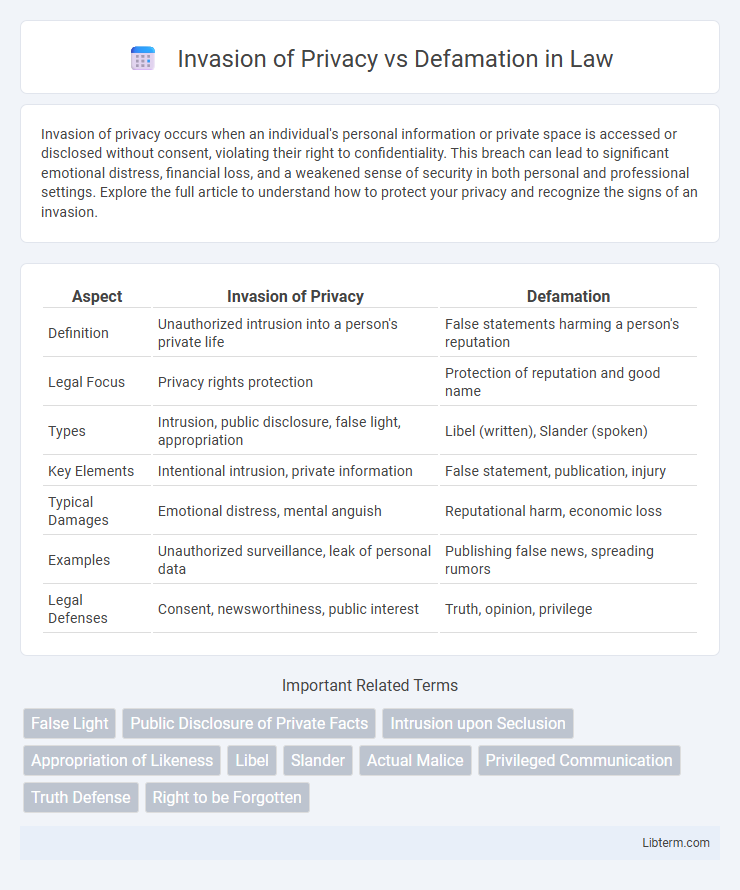Invasion of privacy occurs when an individual's personal information or private space is accessed or disclosed without consent, violating their right to confidentiality. This breach can lead to significant emotional distress, financial loss, and a weakened sense of security in both personal and professional settings. Explore the full article to understand how to protect your privacy and recognize the signs of an invasion.
Table of Comparison
| Aspect | Invasion of Privacy | Defamation |
|---|---|---|
| Definition | Unauthorized intrusion into a person's private life | False statements harming a person's reputation |
| Legal Focus | Privacy rights protection | Protection of reputation and good name |
| Types | Intrusion, public disclosure, false light, appropriation | Libel (written), Slander (spoken) |
| Key Elements | Intentional intrusion, private information | False statement, publication, injury |
| Typical Damages | Emotional distress, mental anguish | Reputational harm, economic loss |
| Examples | Unauthorized surveillance, leak of personal data | Publishing false news, spreading rumors |
| Legal Defenses | Consent, newsworthiness, public interest | Truth, opinion, privilege |
Understanding Privacy Invasion and Defamation
Invasion of privacy involves unauthorized intrusion into an individual's personal life, such as revealing private information without consent or unauthorized surveillance. Defamation is the act of making false statements that harm a person's reputation, including libel (written) and slander (spoken). Understanding the distinction highlights that privacy invasion damages personal confidentiality, while defamation injures social standing through false claims.
Legal Definitions: Privacy vs. Defamation
Invasion of privacy refers to the unauthorized intrusion into an individual's private life, causing harm by exposing personal information without consent. Defamation involves making false statements about someone that damage their reputation, either in written form (libel) or spoken words (slander). Legal definitions distinguish privacy violations as breaches of confidentiality or solitude, while defamation centers on the dissemination of untrue and harmful assertions.
Key Differences Between Invasion of Privacy and Defamation
Invasion of privacy involves unauthorized intrusion into an individual's personal life, such as public disclosure of private facts or false light portrayal, whereas defamation pertains to false statements harming a person's reputation through libel (written) or slander (spoken). Key differences include the nature of the harm--privacy violation versus reputational damage--and the type of information involved, with invasion of privacy focusing on personal, non-public details, while defamation centers on false statements presented as fact. Legal standards and defenses vary; defamation requires proving the falsity of statements and actual harm, while invasion of privacy claims often hinge on intrusion, appropriation, or public disclosure of private facts.
Elements Required to Prove Privacy Invasion
Invasion of privacy requires proving the existence of a reasonable expectation of privacy, an intentional intrusion by the defendant, and that the intrusion would be highly offensive to a reasonable person. Key elements include demonstrating unauthorized access or disclosure of private information and actual damage or emotional distress caused by the intrusion. Unlike defamation, which necessitates false statements harming reputation, invasion of privacy centers on protecting personal solitude and confidentiality without necessarily involving falsehoods.
Essential Elements of a Defamation Claim
A defamation claim requires proving the publication of a false statement presented as fact that injures the reputation of the claimant, causing measurable harm. Essential elements include identification of the plaintiff, defamatory nature of the statement, publication to a third party, fault amounting to at least negligence, and actual damage or harm. Unlike invasion of privacy, defamation specifically centers on reputational damage from false information communicated publicly.
Common Examples of Privacy Invasion
Common examples of invasion of privacy include unauthorized surveillance, such as hidden cameras or wiretapping, and the public disclosure of private facts like medical records or financial information without consent. Intrusion upon seclusion, where someone intentionally intrudes into a private space or private affairs, also exemplifies privacy invasion. Unlike defamation, which involves false statements harming reputation, invasion of privacy centers on the unauthorized exposure or use of personal information.
Illustrative Cases of Defamation
Defamation cases hinge on false statements that damage a person's reputation, distinct from invasion of privacy claims which involve unauthorized disclosure of private information. Notable illustrative cases include New York Times Co. v. Sullivan, where the Supreme Court established the "actual malice" standard for public figures claiming defamation. Another key example is Hustler Magazine v. Falwell, which underscored protection of parody under the First Amendment despite offensive content.
Legal Remedies and Defenses Available
Legal remedies for invasion of privacy often include monetary damages and injunctions to prevent further violations, with defenses such as consent, truth, or lack of reasonable expectation of privacy. In defamation cases, plaintiffs seek compensatory and punitive damages, while common defenses involve truth, opinion, privilege, and the absence of actual malice. Both torts require the plaintiff to prove specific elements, but invasion of privacy emphasizes unauthorized intrusion or disclosure, whereas defamation centers on false statements damaging reputation.
Impact of Digital Media on Privacy and Defamation
The rise of digital media has significantly blurred the lines between invasion of privacy and defamation, amplifying the speed and reach of both harms. Social media platforms and online publications often disseminate private information without consent, exacerbating privacy violations while simultaneously spreading potentially defamatory statements. This digital environment challenges traditional legal frameworks as courts grapple with balancing freedom of expression against protecting individuals' reputations and personal privacy.
Protecting Yourself: Best Practices and Prevention
To protect yourself against invasion of privacy and defamation, regularly review and update privacy settings on social media platforms to limit personal information exposure. Maintain detailed records of any defamatory statements or privacy breaches, including screenshots and timestamps, to support potential legal action. Consulting with a legal expert promptly ensures tailored advice and effective strategies for preventing and responding to these violations.
Invasion of Privacy Infographic

 libterm.com
libterm.com